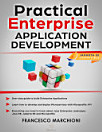Hands-On Cloud-Native Applications with Java and Quarkus: Build high performance, Kubernetes-native Java serverless applications
About this ebook
Quarkus is a new Kubernetes-native framework that allows Java developers to combine the power of containers, microservices, and cloud-native to build reliable applications. The book is a development guide that will teach you how to build Java-native applications using Quarkus and GraalVM.
We start by learning about the basic concepts of a cloud-native application and its advantages over standard enterprise applications. Then we will quickly move on to application development, by installing the tooling required to build our first application on Quarkus. Next, we’ll learn how to create a container-native image of our application and execute it in a Platform-as-a-Service environment such as Minishift. Later, we will build a complete real-world application that will use REST and the Contexts and Dependency injection stack with a web frontend. We will also learn how to add database persistence to our application using PostgreSQL. We will learn how to work with various APIs available to Quarkus such as Camel, Eclipse MicroProfile, and Spring DI. Towards the end, we will learn advanced development techniques such as securing applications, application configuration, and working with non-blocking programming models using Vert.x.
By the end of this book, you will be proficient with all the components of Quarkus and develop-blazing fast applications leveraging modern technology infrastructure.
What you will learnBuild a native application using Quarkus and GraalVMSecure your applications using Elytron and the MicroProfile JWT extensionManage data persistence with Quarkus using PostgreSQLUse a non-blocking programming model with QuarkusLearn how to get Camel and Infinispan working in native modeDeploy an application in a Kubernetes-native environment using MinishiftDiscover Reactive Programming with Vert.xWho this book is forThe book is for Java developers and software architects who are interested in learning a promising microservice architecture for building reliable and robust applications. Knowledge of Java, Spring Framework, and REST APIs is assumed.






